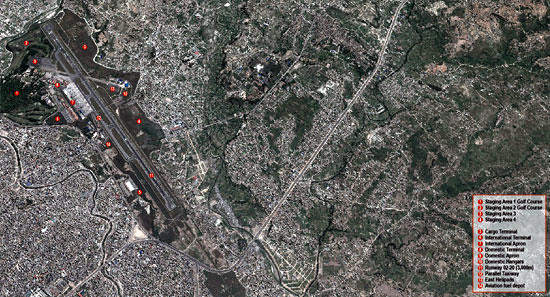Attention turns to preparing Kathmandu airport to receive relief after the next big earthquake
Many people living in Kathmandu Valley’s densely populated core will not have much of a chance of survival when the next big earthquake strikes. So disaster preparedness experts are turning their attention to making sure Nepal’s only international airport will be operational to fly in relief.
Historical records show that earthquakes of magnitude 8.0 and above have hit central Nepal regularly every 80 years on average. The last one was in 1934, when at least 10,000 people were killed in the Valley although the epicentre was 150km to the south in India.
An earthquake of the same intensity would kill more than 100,000 people outright in Kathmandu Valley, experts estimate, leaving double that number seriously injured and up to 1.5 million people homeless. Survivors will face serious shortages of food, shelter, and medicines. Highways leading to Kathmandu will have been blocked by landslides and the airport will be damaged.

@ 2012 GEO GOOGLE EARTH
PUTTING IT ON THE MAP: A Google Earth image shows how Kathmandu airport is now subsumed by the city.
A 7.0 magnitude quake in the Haitian capital, Port-au-Prince, in 2010 killed 200,000 people and damaged the city’s Toussaint L’Ouverture International Airport. Relief supplies couldn’t get in for three days until the US military repaired the runway and flew in air traffic controllers and navigation equipment.
Kathmandu’s Tribhuvan International Airport has only one runway and geological tests have shown that parts of it are vulnerable to liquefaction damage during an earthquake. Just thinking about it is scary for Kathmandu airport’s Operation Chief Deo Chandra Lal Karna. He says: “It is a huge challenge, but if all goes well we can be better prepared.”
Learning from the Haiti experience, the Civil Aviation Authority of Nepal (CAAN) recently prepared a ‘TIA Disaster Response Plan’ with help from the US Army Corps of Engineers (USACE), the Federal Aviation Administration (FAA), and Canada’s University of British Columbia. It lays out emergency response for the first 72 hours to repair damage, restore flight operations, prepare staging areas, and logistics for flying in relief.
The plan covers overseas humanitarian assistance for one month and housing for 1,000 emergency personnel in the open areas around the airport, including the golf courses. A team of engineers from the Nepal Army’s Kali Baksh Battalion have been trained by the Hawaii-based USACE on emergency repairs after an earthquake.
“We have learnt from Haiti’s disaster and lack of preparedness and want to avoid the same happening here in Nepal,” explains Punya Shakya, project director of TIA Improvement Project at CAAN. Kathmandu Valley needs about 4,000 tons of food every day and the currently airport can only receive 533 tons daily. The airport could be Kathmandu’s only lifeline to the outside world and will be the entry point for food, medicine, tents, and international rescue personnel. But unlike Haiti, which is only a two hour flight from Florida, Nepal is 10 hours away from the nearest US military base in the Pacific or Indian Ocean. Help from India could be limited because a big earthquake in Nepal would also devastate northern India.

TARIKU TESHALE
A US military C-130 at TIA
“We now have a plan that will ensure that our airport is more prepared and the Home Ministry will give full support to the response plan,” said Pradip Koirala, joint secretary and a senior member of the ministry’s disaster management unit.
In September, the airport authorities are organising a full-scale drill to rehearse rapid response and practice coordination between airport officials, the Home Ministry’s National Emergency Operation Centre (NEOC), rescue and fire fighting services, the army, police, hospitals, and aid agencies.
The airport’s runway is 3,000m long and can accommodate military cargo jets like the C-4 and C-130s and wide-body 747s, but if jets will not be able to land. Bhairawa and Pokhara airports are being upgraded, but won’t be ready for at least three more years.
For now, the TIA Disaster Response Plan needs to be taken to another level: funding. The airport immediately needs $1 million for prepositioning of food and other emergency relief supplies and equipment. Another $10 million is needed for the airport to be fully prepared.
“The planning at the moment is at an advanced level, but there is a gap in funding support,” says Andrew Martin, head of UN’s Office for the Coordination for Humanitarian Affairs (OCHA), which is part of the Nepal Risk Reduction Consortium.
Under the plan, the UN’s World Food Program (WFP) is supposed to take the lead in coordinating logistics with the government and locating humanitarian staging grounds.
Read also:
Thinking the unthinkable
Not if, but when